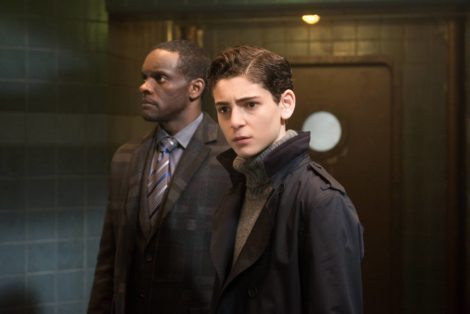Synopsis of 2×21: Bruce, Luke Fox and Gordon infiltrate Arkham to rescue Selina and bring down Strange. The Court of Owls questions Hugo’s successes in raising the dead. Nygma begins interrogating Bruce. Clayface takes Gordon’s form.
Rating: ★★★★☆
When Gotham was first announced, there were a lot of expectations for what exactly the show was going to be, with so many pointing to a series drawing inspiration from Gotham Central to tell traditional, procedural crime stories with a super heroic flair. More or less, that’s the tone the show’s gone with for the last two seasons and it’s often struggled to balance those procedural elements with satisfying fans who just want to see Batman villains in a new setting. It’s a decidedly unadventurous approach to the source material but it’s an understandable one.
![[The CW]](http://www.nerdophiles.com/wp-content/uploads/2016/05/gotham_221JN_0256_hires1-470x313.jpg)
“A Legion of Horribles,” this week’s episode, offers a decidedly different approach to the show and one that’s decidedly more interesting. It’s a show that could focus on Bruce Wayne’s path without being too cute or too winking and keeping the focus on a boy trying to come to terms with unknowable trauma by embracing the cowl.
That may sound like I’m giving too much credit to Gotham and maybe I am. There’s a lot in this episode that doesn’t work. Not even a little. The arrival of the Court of Owls is absolute nonsense and the way they connect to Hugo Strange’s experiments is silly and trite. The scenes where Strange continues to manipulate a group on insane inmates into believing they’re actually would-be super villains robs those characters of what makes them special and interesting. It’s the kind of retroactive continuity that tries to explain away something intrinsically comic-bookish with something supposedly more mature or realistic and it just ends up muddling what makes these characters work.
![[FOX]](http://www.nerdophiles.com/wp-content/uploads/2016/05/gotham_221JN_0208_hires1-470x313.jpg)
You see this a lot in comics from the mid to late 2000s. Stories like “Identity Crisis,” “Spider-Man: Sins Past,” “Trouble” and “X-Men: Deadly Genesis” try to make decidedly comic-bookish stories and goofier concepts into something that feel timely. It’s the mindset that thinks the Justice League needs to respond to rapist supervilllains or that Gwen Stacy had sex with Norman Osborne or that Xavier sent another team of mutants to die and hid the evidence. These are the kinds of stories that inevitably are meant to add shades of grey to heroes and concepts but they rarely actually do that. Inevitably, they end up sullying generally likable characters, pushing them too far and undoing far more than just one moment of Silver Age goofiness.
While Strange’s scenes here, particularly the ones with Clayface and Firefly operate on this flawed logic, the scenes with Bruce use that same sense of retroactive continuity much better. See, there’s always a tendency to go back in time and tell stories about characters when they were younger, less sure of themselves and forced to push themselves or question who they are. That thinking has given classic stories, like “Year One” “The Winter Soldier,” or “Punisher: Born,” stories that use the freedom of the character’s unexplored past to give a new sense of who they are today.

Bruce’s plot here depends on him having to question exactly what lead to his parent’s death and whether he’s potentially making the same decisions that lead to their demise. He’s putting people in danger based on his own unflinching ideals and Strange simply offers him to give up those beliefs in favor of saving the people closest to him. It’s both a relatable story and one that’s resolution helps to define who Batman is, a resolute champion of justice.
“A Legion of Horribles” goes through all of Bruce’s thinking here, from his decision to put more and more people in danger to rescue Selina, to considering whether he’s made the wrong choice when talking to Strange, to accepting that he’s working for something larger than himself by episode’s end. It’s a compelling portrait of a tortured young man by the end, acknowledging the pain Bruce Wayne’s had to deal with since his parent’s death while forcing him to realize that ignorance gives him a potential out. It’s one of those stories that feels immediately obvious, that Gotham should have told a long time ago but it’s smart and well done here.
![[FOX]](http://www.nerdophiles.com/wp-content/uploads/2016/05/gotham_221JN_0590_hires1-470x313.jpg)
There’s some other strong work here as well. Distance has only benefitted Jada Pinkett Smith’s portrayal of deposed mob boss Fish Mooney and her return here is a lot of campy fun. Pinkett Smith always gave the impression that she was the only one having fun in the first season of the show and she’s clearly giving another performance that’s equal parts snarling and winking here. A newly empowered Fish starts plotting her next move as soon as she shows up on screen and it’s genuinely fun to watch her scheme and try out what she’s capable of. Bullock’s also trying out a new role in this episode, trying his best to act the part of responsibility and control from the head office of the GCPD. He gets a couple solid zingers and Donal Logue infuses the character with an uneasy, performative gravitas that fits a guy used to skating by suddenly receiving a city’s worth of attention.
Much of the episode is devoted to putting all of the main characters in position in and around Arkham Asylum for the finale and there’s enough going on for a potentially explosive final episode. I’m cautiously optimistic. Gotham has had problems sticking the finale in past midseason- and season-finales and it has an awful lot of balls in the air going into next week. Still, “A Legion of Horribles” offers some of the best character work of this season and it’s genuinely impressive to see, despite some major flaws still showing.